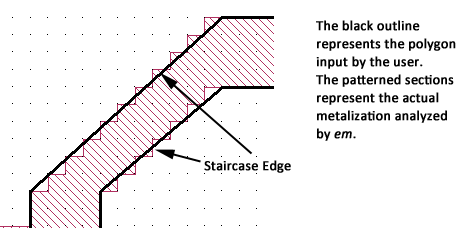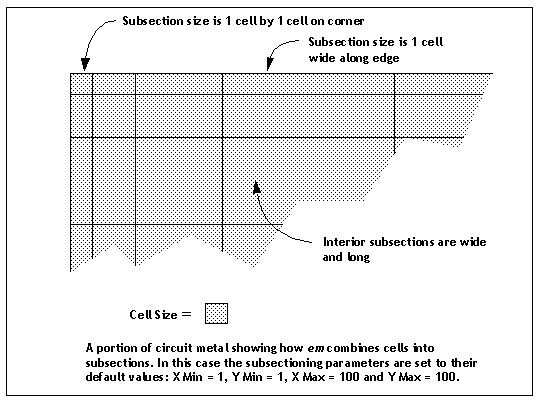By default, Sonnet fills a polygon with “staircase” subsections. Other, more advanced fill types (diagonal and conformal) can be used. For diagonal subsections, see Diagonal Fill Subsectioning. For conformal mesh, see Conformal Mesh Subsectioning. This discussion applies to staircase fill.
This fill type is referred to as staircase because when using small rectangular subsections to approximate a diagonal edge, the actual metalization takes on the appearance of a staircase, as in the example shown below.

The default values for the subsectioning parameters are X Min = 1, Y Min = 1, X Max = 100 and Y Max = 100. These numbers specify the smallest and largest allowed dimensions of the subsections in a polygon. With X Min = 1, the smallest subsection in the X dimension is one cell. With X Max = 100, subsections are not allowed to go over 100 cells in length.
The illustration below shows how these default subsectioning parameters are used. Notice in the corner, the subsection size is just one cell. The current density changes most rapidly here, thus, the smallest possible subsection size is used.

As we go away from the corner, along the edge, the subsections become longer. For example, the next subsection is two cells long, the next one is four cells long, etc. If the edge is long enough, the subsection length increases until it reaches X Max (100) cells, or the maximum subsection size parameter, whichever comes first, and then remains at that length until it gets close to another corner, discontinuity, etc.
Notice, however, that no matter how long the edge subsection is, it is always one cell wide. This is because the current density changes very rapidly as we move from the edge toward the interior of the metal (this is called the edge singularity).
In order to allow an accurate representation of the very high edge current, the edge subsections are allowed to be only one cell wide. However, the current density becomes smooth as we approach the interior of the metal. Thus, wider subsections are allowed there. As before, the width goes from one cell to two cells, then four, etc.
 If two polygons butt up against each other or have a small overlap, the modeling of the edge singularity will require a larger number of subsections at the boundary between the two polygons. Using the Union command (Edit - Boolean Operations - Union) to join the two polygons into one will reduce the number of required subsections and speed up your analysis.
If two polygons butt up against each other or have a small overlap, the modeling of the edge singularity will require a larger number of subsections at the boundary between the two polygons. Using the Union command (Edit - Boolean Operations - Union) to join the two polygons into one will reduce the number of required subsections and speed up your analysis.
Conversely, if you have an area of your circuit at which you desire greater accuracy, using the Divide (Edit - Divide) command at the point of interest to create two polygons, forces the analysis to use smaller subsections in order to model the edge singularities.